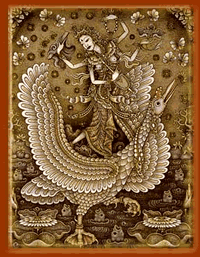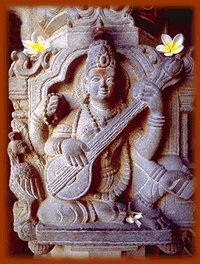
Saraswati
In the ancient sacred Hindu text the Rig Veda, Saraswati is represented as a river deity, goddess of the Indus Valley river of the same name. At the time when the Vedas were written, worship was primarily performed on the banks of the river, with sacrifices consigned to Agni, the sacred ritual fire.
When the Saraswati river dried up in the 4th millenium BCE, ritual and belief underwent transformation that was subsequently explained in the Upanishads. It was said that the gods entrusted Saraswati with the task of taking Agni to the sea. Prior to this time, the sacrifical fire had been seen as the sole link between humans and their deities. But when Saraswati completed her mission and returned Agni to the sea, the ritual of sacrifice came to be replaced by a sacrifice of self through the pursuit of creativity and knowledge.

Playing the veena
From the Brhaddharma Purana
As goddess of learning, Saraswati has bestowed a great gift to humanity: the wealth of knowledge. She is known in many religions: in Jainism, she is called the dispeller of darkness and ignorance, in Buddhism she confers wisdom and learning. The Japanese goddess Benten is also seen as a manifestation of Saraswati; her full name, Dai-Ben-Zai-Ten, means ‘the great divinity of the reasoning faculty’.
We all, at some time, have experienced the spark of creativity, and artists, writers and other individuals involved in creative endeavours have for millenia performed pilgrimages to Saraswati’s temples to ask for inspiration.
The goddess is often depicted holding the veena, a musical instrument similar to a sitar; sara is the Sanskrit word meaning ‘essence’, and swa means ‘self’, therefore seeking to manifest our creative power—to be ‘in tune’ with it—could be seen, perhaps, as an appropriate devotion.
Nora Leonard, January 2004